Tag Archive: AAC system
August 10, 2017
by Carole Zangari -
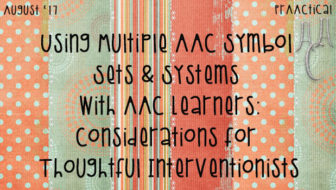
PCS, Pixons, Minspeak symbols, Smarty Symbols, Symbol Stix, CoughDrop Symbols, ARASAAC symbols, Mulberry symbols, Lesson Pix, Sclera symbols, and more. In terms of AAC symbol options, we are living in plentiful times. It isn’t uncommon to see situations like Jonah’s. On a typical school day, Jonah is likely to encounter at least three types of pictures for the same words. He has Smarty Symbols on his AAC app and a classroom core board with PCS, and is using instructional materials using Symbol Stix. These are each great ways of visually representing language, but here’s something to think about: Does it help or hurt Jonah to have 3 different pictures for the same word? There are many options in symbol sets and systems, and each has its own strengths and weaknesses. Here are some things to think about as you and your team are making these decisions. There is no empirical... [Read More...]
Filed under: Featured Posts, PrAACtical Thinking
Tagged With: AAC system, picture symbols
October 7, 2012
by Carole Zangari -
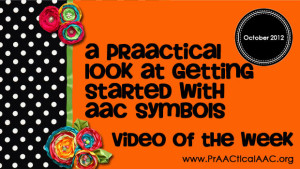
For this week’s video, we head back to the Aaron W. Perlman Center at Cincinnati Children’s Hospital Medical Center for a wonderful video about getting started with AAC symbols. We know you will enjoy this overview of some of the most popular AAC symbols and the lovely examples they share. –
Filed under: Video of the Week
Tagged With: AAC system, choice making, getting started, implementation ideas, intervention, symbol
July 18, 2012
by Carole Zangari -
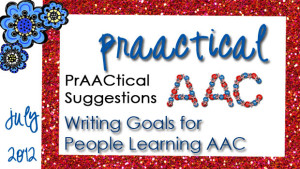
This post was inspired by a budding young professional who loves AAC and is DETERMINED to provide best practice services for the young students she serves. (See?? This is why we love being clinical educators!) We were chatting about a youngster on her caseload who uses an eyegaze SGD and is making some good progress with the technical aspects of it. Our conversation turned to goal setting. – First, a word about how to talk about AAC in the goals and objectives. For people who use SGDs, there are pros and cons to naming the actual device in the goal. Some SLPs favor that, while others prefer a more flexible approach and describe the device features. More about that another time. A more general concern about writing AAC goals is the tendency to focus more on operating equipment than on becoming an effective communicator. Clearly, we advocate the latter: AAC... [Read More...]
Filed under: PrAACtical Thinking
Tagged With: AAC system, communicative competence, goals, intervention, language, linguistic competence, objectives, operational competence, social skills, strategic competence
February 4, 2012
by Carole Zangari -
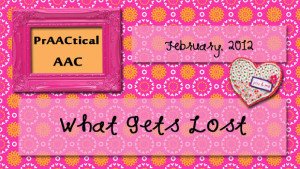
Imagine having one key communication strategy and no one knew that it existed. This horrifying experience was documented in the book ‘I Raise My Eyes to Say Yes,’ the autobiography of Ruth Sienkiewicz-Mercer. For years, she effectively used eye gaze with her family to answer yes/no questions, but when Ruth was placed at a residential facility, things eventually changed. Staff turnover, something we’re all familiar with, was the culprit. With time, new staff came in and didn’t realize that Ruth communicated with her eyes. Ruth was silenced for years until someone noticed that her ‘eyes up’ movement wasn’t reflexive or random. She was talking, but no one was listening. — While this was an extreme example, most AAC practitioners can recount their own stories of people whose AAC messages weren’t effectively translated once they moved to new settings. The transition to a new environment, where untrained partners may fail to recognize... [Read More...]
Filed under: PrAACtical Thinking, Strategy of the Month
Tagged With: AAC system, collaboration, Multimodal, visual literacy
January 14, 2012
by Carole Zangari -
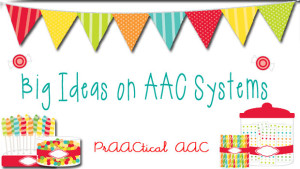
I had some great conversations with families this month about AAC and how to effectively translate strategies from therapy and school to a home environment. Although their children were all different ages, had various disabilities, and used a diverse set of AAC tools, there were a couple of common elements in those conversations.One thing that played a central role was this question: What IS an AAC system? We all know the textbook definition of AAC and that it refers to a set of tools, techniques, and strategies used to enhance the communication of people with significant language difficulties. We know that AAC is often subdivided into unaided communication (including gestures, signs, movement, vocalization, etc) and aided communication (such as communication books, speech generating devices [SGDs], and choice boards).But the general case is only helpful if you’re in AAC class or studying for the PRAXIS. In clinical practice, we need to... [Read More...]
Filed under: Strategy of the Month
Tagged With: AAC system, intervention, modes of communication, Multimodal, SGD
January 4, 2012
by Robin Parker -

2012 is here and we have been reflecting on some videos (just a few) that will remain in our PrAACtical tool box. These videos ‘say’ it better than any words, lecture, or article. They inspire active exploration into the topic as you think about AAC systems & inclusion at home and the community. About Core Words About Employment And the program expands For critics of technology
Filed under: PrAACtical Thinking
Tagged With: AAC system, inclusion
January 4, 2012
by Robin Parker -
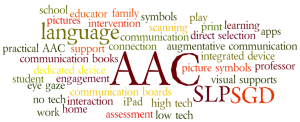
Welcome to the PrAACtical AAC Strategy Series! Each month we hope to focus on a new topic related to AAC intervention. Over time, we plan to cover the things that we’ve found to be important in our work with scores of graduate student SLPs and families. We’ll try to do a post each Saturday with information on that AAC topic. Early on, we’ll focus on some of the AAC basics and then progress into more strategies. Throughout the week, we’ll try to tie in some of our other posts to the monthly strategy when that seems to make sense. Look for info, anecdotes and links designed to flesh things out and extend the conversation a bit. Speaking of intervention, here’s something we’ve noticed: Information about communication strategies is sometimes written for a narrow audience, but has broader applicability. Try to keep an open mind and check out the links to sites, articles, and... [Read More...]
Filed under: Strategy of the Month
Tagged With: AAC system, SLP






